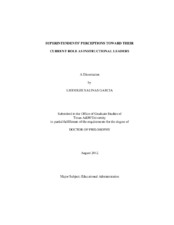| dc.contributor.advisor | Madsen, Jean | |
| dc.contributor.advisor | Torres, Mario | |
| dc.creator | Garcia, Liodolee Salinas | |
| dc.date.accessioned | 2012-10-19T15:30:54Z | |
| dc.date.accessioned | 2012-10-22T18:02:32Z | |
| dc.date.available | 2012-10-19T15:30:54Z | |
| dc.date.available | 2012-10-22T18:02:32Z | |
| dc.date.created | 2012-08 | |
| dc.date.issued | 2012-10-19 | |
| dc.date.submitted | August 2012 | |
| dc.identifier.uri | https://hdl.handle.net/1969.1/ETD-TAMU-2012-08-11722 | |
| dc.description.abstract | This study was conducted to identify the self-perceptions of superintendents regarding their instructional leadership practices. The focus of the research was to explore the linkages that exist between these perceptions and factors such as superintendent characteristics and district demographics. In their role as district instructional leaders, superintendents are increasingly held accountable for instruction and the expectation for increased test scores.
The data used to explore the research questions were acquired through a survey, the Superintendent's Instructional Leadership Survey (SILS). This instrument was developed by Gwen Boyter and had previously been used to survey superintendent behavior as perceived and self-reported by the superintendents themselves. The questionnaire contained 42 task statements that were intertwined into five task areas relevant to Instruction and Human Resource Development.
This study used a Multiple Logistical Regression to explore the relationship between the superintendents' self-perceptions on their instructional leadership role and variables that may significantly influence the superintendents' perceptions. Variables included: school district rating for student performance on the state assessment; percentage of economically disadvantaged and at-risk student groups; and superintendent characteristics, such as age, gender, ethnicity, and years of experience. The SILS was sent as an online survey through Qualtrics.com. Superintendents rated their instructional leadership behaviors on a Likert scale that ranged from "Constant Emphasis" to "No Emphasis." Forty-nine respondents completed a survey, which was 16% of those surveyed.
Practical significance was found in the relationship between the superintendents' self-perceptions and two of the variables: (a) the superintendents' age and (b) the district rating. Statistical significance was found on two variables: (a) the percentage of economically disadvantaged students and (b) the percentage of at-risk students.
Research findings suggest that it is imperative that superintendents devote specific time to focus on instruction, curriculum, and assessment practices. They must involve stakeholders to collaboratively focus on the instruction goals in order to meet the learning needs of all students. As a result of this study, instructional leadership should be given much consideration in the selection of superintendents. Superintendent preparation programs can use data from the study to better prepare individuals to serve in the capacity of district instructional leaders. | en |
| dc.format.mimetype | application/pdf | |
| dc.language.iso | en_US | |
| dc.subject | Instructional leadership | en |
| dc.subject | superintendents | en |
| dc.subject | instruction, curriculum, assessment practices. | en |
| dc.title | Superintendents' Perceptions Toward Their Current Role as Instructional Leaders | en |
| dc.type | Thesis | en |
| thesis.degree.department | Educational Administration and Human Resource Development | en |
| thesis.degree.discipline | Educational Administration | en |
| thesis.degree.grantor | Texas A&M University | en |
| thesis.degree.name | Doctor of Philosophy | en |
| thesis.degree.level | Doctoral | en |
| dc.contributor.committeeMember | Nafukho, Fredrick | |
| dc.contributor.committeeMember | Larke, Alvin | |
| dc.type.genre | thesis | en |
| dc.type.material | text | en |


